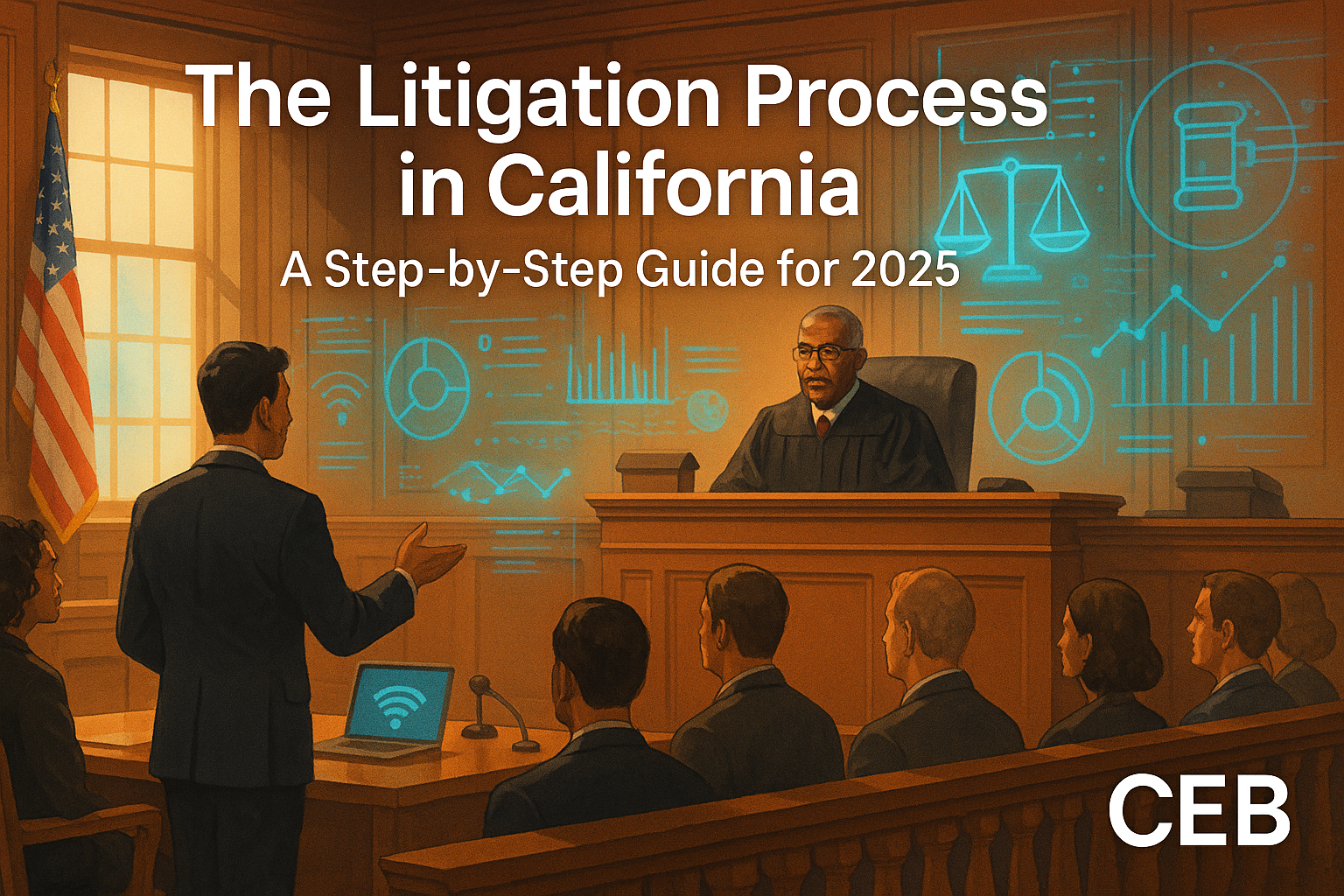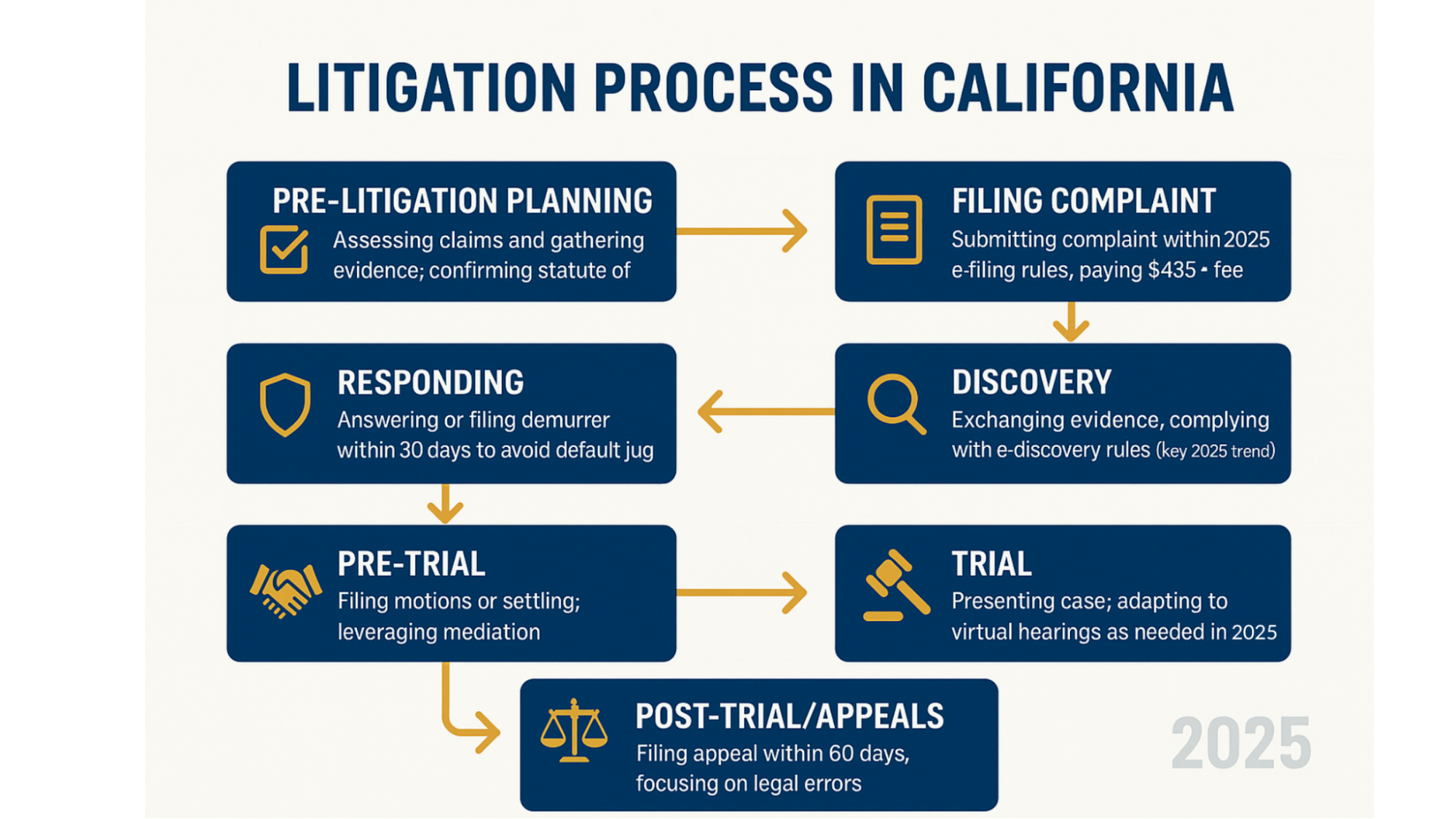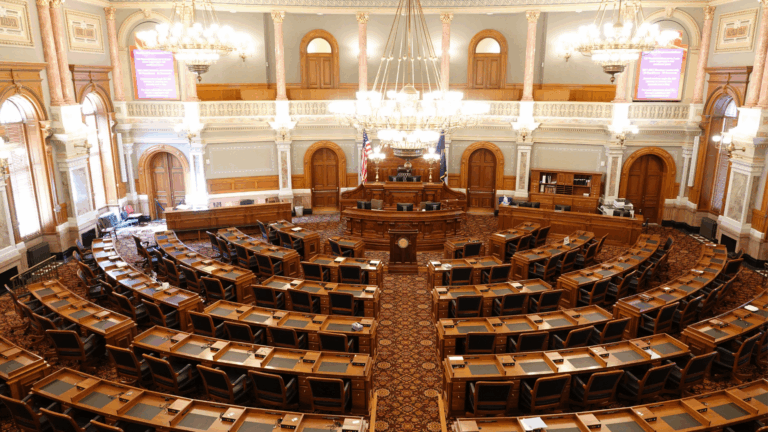
For many attorneys, the litigation process in California in 2025 is like preparing for a high-stakes marathon. One where every step counts, and a single misstep can throw off your entire strategy.
For seasoned attorneys, the state’s court system —the largest in the U.S.— presents familiar challenges, with new twists like expanded e-filing mandates and AI-driven case management tools.
The pressure of tight deadlines and intricate local rules can weigh heavily, but you’ll stay ahead of the curve with the right approach and resources. Legal research tools, CEB practice guides, and California law books are your allies in this journey.
Explore the litigation process in California below, offering nuanced insights, 2025-specific updates, and advanced resources to ensure you’re trial-ready with confidence.
Step 1: Pre-Litigation Planning – Assess Your Case for 2025 Success
Before launching into the litigation process in California, keen planning is your foundation. At this stage, you:
- Gather evidence
- Identify viable claims
- Weigh settlement options like mediation, which California courts increasingly favor in 2025, to ease docket pressure.
For example, for an attorney representing a tech startup in Oakland, this might mean:
- Analyzing contracts and correspondence to assess a breach of contract claim
- Considering predictive analytics—a 2025 trend—to gauge success likelihood.
Each phase of this process demands precision, especially given California’s county-specific procedural nuances. Our CEB OnLAW Pro legal research tool provides access to the latest statutes and case law to quicken the process.
Use CEB practice guides for detailed checklists for these timelines, while legal research firms provide analytics to benchmark your case against recent California outcomes.
Step 2: Filing the Complaint – Requirements in California for 2025
Your next step is filing the complaint, detailing your client’s claims, legal basis, and requested remedies. As of May 15, 2025, 36 superior courts have adopted e-filing for civil cases, and it varies county by county. Counties like San Francisco mandate it, while others, like rural Mono County, are still transitioning.
Practical Considerations
For a Silicon Valley attorney filing a trade secrets case, ensuring compliance with Santa Clara County’s e-filing system is critical. Filing Costs: Fees for unlimited civil cases start at $435, but local surcharges may apply.
Missing a requirement can lead to rejection—a costly delay. CEB practice guides provide sample complaints tailored to California courts. Here is a filing Checklist:
- Ensure all documents are in PDF format for e-filing
- Verify county-specific requirements via CEB’s Practitioner platform
- Confirm payment of filing fees, including local surcharges
Step 3: Responding to the Complaint – Options and Deadlines in California
Once served, the defendant has 30 days to respond under California law, with options including an answer, demurrer, or a motion to strike. For an attorney defending a Fresno client in a contract dispute, a demurrer might challenge the complaint’s lack of specificity on contract terms, buying time to strategize.
That 30-day clock ticks loudly—miss it, and a default judgment could derail your case.
Precision here sets the tone for the entire case, and CEB’s Practitioner platform provides case law to support your response, while CEB practice guides offer sample motions to ensure compliance with California standards.
Here is a CEB sample demurrer to craft a response that withstands scrutiny.
Step 4: Discovery – Gathering Evidence in California Courts
Discovery is a pivotal phase of the litigation process that involves exchanging evidence through depositions, interrogatories, and document requests, under the Discovery Act Code.
In 2025, e-discovery is non-negotiable in tech-heavy counties like Alameda, where courts expect digital submissions. For a Sacramento attorney in a personal injury case, this might mean requesting medical records electronically while ensuring compliance with court deadlines.
Last year, the City of Los Angeles was sanctioned $2.5 million for discovery abuses, including asserting privileges in bad faith and refusing court orders. The case, decided by the California Supreme Court, highlights the importance of compliance during discovery.
Over-requesting can backfire—California judges may view it as a delay tactic, so focus on precision. CEB discovery tools help you craft targeted requests that keep you in the court’s good graces.
Step 5: Pre-Trial Strategies – Motions and Settlements in California
Your fifth step is the pre-trial strategies, which include motions like:
- Summary judgment to narrow issues
- Settlement negotiations to avoid trial
With California courts pushing mediation in 2025 to reduce trial loads, a San Jose attorney in a landlord-tenant dispute might use discovery evidence to negotiate a favorable settlement, saving time and costs.
A strategic settlement can turn a tense standoff into a win for your client.
Top 3 Pre-Trial Mistakes to Avoid
- Overlooking mediation opportunities —California judges favor mediation.
- Filing motions without local court rule compliance —check county specifics.
- Ignoring cost-saving arguments in settlement talks —judges appreciate efficiency.
Step 6: Trial in California
Trial is the high-stakes culmination of the litigation process in California, which requires keen preparation including:
- Organizing evidence
- Coaching witnesses
- Drafting statements
What to Expect in 2025 California Trial Trends
- Jury selection varies by region; a Silicon Valley jury might favor data-driven arguments, reflecting the area’s tech culture.
- Virtual trials are increasingly common in 2025 for smaller cases. So, digital fluency for remote hearings means ensuring your video evidence is clear and accessible.
- Judges value brevity, and overloading evidence can dilute your impact, so keep arguments sharp and compelling.
Step 7: Post-Trial and Appeals – Final Steps in California
Post-trial, the litigation process in California may involve motions for a new trial or appeals to the California Appellate Court. Appeals, focusing on legal errors, must be filed within 60 days of judgment. That deadline is unforgiving. You miss it, and your client’s options vanish.
CEB’s OnLAW Pro provides appellate case law and procedural rules to build a strong appeal. Every argument must be rooted in law, not emotion, to have a chance at success. Start your appeal research early to meet the deadline.
Master the Litigation Process in California with Confidence
Whether you’re representing individuals or large corporations, the litigation process in California can test even the most seasoned attorneys. In 2025, with courts embracing technology and new rules, preparation is your greatest asset.
Your clients rely on your expertise to safeguard their interests. Partner with the right legal research firm for California-specific legal research tools. CEB practice guides designed for California’s unique court system provide unmatched support for litigators who understand its demands.





